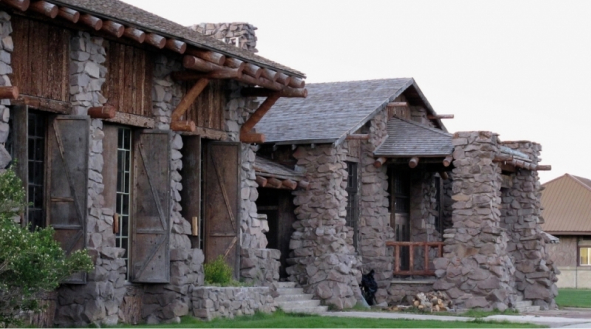Be sure to check out our Winter Guided Tours page!
Winter Wildlife
While Yellowstone is home to many species, there are only a select few that peak their heads out during the winter months.
- Wolves: Yellowstone is home to roughly 99 wolves that live within 10 packs. It's known as one of the best places to view these creatures and the contrast of the wolves' grayish fur against the white snow make winter a prime time for spotting them.
- Bison: In the winter, these hairy beasts are often spotted closer to the West Entrance along the Madison River or near warm pools by Old Faithful.
- Bighorn Sheep: Look for these nimble creatures along rocky hillsides or cliff areas.
- Coyote: Coyotes and foxes can be spotted hunting in vast snow-covered meadows. To see one pounce on its prey is quite exciting.
- Bald Eagle: Keep your eyes peeled for their dark bodies and white heads. You'll often spot them in trees above rivers.
What's Open
Most park roads close to vehicles for the winter season, with the exception of the road connecting the North Entrance at Gardiner, Montana and the Northeast Entrance at Silvergate and Cooke City, Montana. This northern road offers access to Mammoth Hot Springs, Tower Roosevelt, and the Lamar Valley, a wildlife hot spot. Other park roads are open to guided over-snow vehicles including snowmobiles and snowcoaches. Take a winter guided tour to view wildlife or to access the Old Faithful Snow Lodge, where you can spend the night in the winter and explore the area via snowshoes or cross country skis. View the Yellowstone Road Closure Schedule for more details.
Where to Go
- Mammoth Hot Springs: While its summer elk herds have already migrated south in the winter, this area offers great wildlife viewing potential in the winter, especially for bison, coyotes, and eagles.
- Lamar Valley: Accessible via 4 wheel drive car, Lamar Valley is located in the northeast corner of Yellowstone. This region is the primary home to Yellowstone's wolf packs, but it is also common to spot bison, mule deer, and coyotes as they retreat from high ridges to the lower meadows in search of food.
- Firehole River: Primarily accessible via guided tour, the Firehole River is located between the Madison Junction and Old Faithful and is a popular area for spotting trumpeter swans as they feed on vegetation in this shallow river. Bison are also often spotted along the nearby Madison River.
- Old Faithful: You'll have to get here on a snowmobile or snowcoach tour, but once you are here there are many options for exploring snow covered trails on snowshoes or cross country skis. Keep watch for bison, who tend to stand in warm springs and pools.
- Grizzly & Wolf Discovery Center: Just outside the park's west entrance, the Grizzly & Wolf Discovery Center is open year-round. The center welcomes visitors to observe bears and wolves in habitats that emulate the wild. Since the grizzlies at this center do not hibernate, you can view them year-round.
- National Elk Refuge: South of Yellowstone, thousands of elk migrate out of the park to winter in the National Elk Refuge near Jackson Hole. You can view these spectacular creatures from viewpoints but the best way to see them is on a guided sleigh ride through the refuge. Sleigh rides depart multiple times a day throughout the winter months.
Get the most bang for your buck by joining a guided tour, via 4x4 car, snowcoach, or snowmobile, into Yellowstone National Park. Wildlife guides have unparalleled knowledge of the area and the best wildlife viewing zones. They know where to go for maximum wildlife viewing, how to keep you warm, and they'll surely teach you a thing or two about Yellowstone. See a list of guides & outfitters on our winter guided tours page









